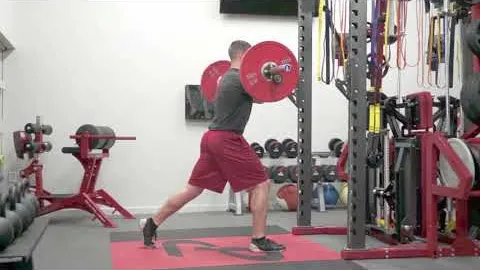
If you're looking to build strength, improve lower body stability, and enhance your overall athletic performance, the Barbell Front Rack Split Squat is an exercise you should consider incorporating into your training routine. This compound movement targets multiple muscle groups and can be a valuable addition to any strength training program.
Before diving into the technique and execution of the Barbell Front Rack Split Squat, let's first examine the numerous benefits this exercise offers:
Leg Muscle Development: The Barbell Front Rack Split Squat primarily targets the quadriceps, hamstrings, and glutes. By performing this exercise regularly, you can expect improved lower body strength and muscle definition.
Unilateral Strength Development: Unlike traditional squats, the Barbell Front Rack Split Squat is a unilateral exercise, meaning that it targets each leg individually. This helps to address any muscular imbalances that might exist between your legs, reducing the likelihood of injuries and improving overall symmetry.
Improved Stability: The stability required during the execution of the Barbell Front Rack Split Squat engages your core and other supporting muscles, promoting better balance and coordination.
Increased Flexibility: This exercise demands greater flexibility in the hip flexors and ankle mobility, leading to increased range of motion over time.
Enhanced Athletic Performance: By strengthening the muscles involved in running, jumping, and change of direction, the Barbell Front Rack Split Squat can have a positive impact on your athletic performance.
Now that you are aware of the benefits, let's delve into the step-by-step guide on how to properly execute the Barbell Front Rack Split Squat:
Equipment Required: You will need a barbell, a squat rack, and a weight plate appropriate for your fitness level.
Step 1: Set Up
Step 2: Barbell Setup
Step 3: Execution
Tips for Proper Form:
As with any exercise, it is crucial to prioritize safety and listen to your body. Here are a few safety precautions and modifications to consider:
Warm-Up: Prioritize a warm-up routine that includes dynamic movements to prepare your muscles and joints for the exercise.
Avoid Overloading: Start with lighter weights and gradually increase the load as you become more comfortable and stronger. This will help prevent strain or injury.
Limit Range of Motion: If you have limited flexibility or mobility in your hips or ankles, you may need to limit your range of motion until you can comfortably perform the full movement.
Substitute with Dumbbells: If you don't have access to a barbell or prefer an alternative, you can perform the split squat using dumbbells or kettlebells held at your sides.
Consult a Professional: If you have any pre-existing injuries or concerns, it is always advisable to consult with a qualified fitness professional or healthcare provider before adding the Barbell Front Rack Split Squat to your exercise routine.
The Barbell Front Rack Split Squat is a powerful exercise that can significantly benefit your muscular development, stability, and athletic performance. By incorporating this exercise into your strength training routine, you can elevate your lower body strength, address muscle imbalances, and enhance overall functional fitness. Remember to prioritize safety, proper form, and gradually progress in weight as you become more proficient in the movement. Happy training!
If you're looking for a gym, fitness club or yoga studio, you've come to the right place.
You can find information about gyms in your area. Browse catalog of gyms and find gyms with classes which are you looking for.
On gym page you can find simple information like address, phone or website. You can find list of available classes. You can check availability of personal training or small group classes. On place page you can also see information about open hours.
You can find gyms near you with amenities, courts, studios and equipments.
Use our map to find gym at your city or district.
In Gym Navigator you can find list of exercises with movies for many body parts.
You can browse exercises catalog and find exercises the best of you.
You can also find exercises grouped into workout plans, which you can use to improve you body. Each routine show you exercises one by one and give you possibility to count you progress and count down rest time.